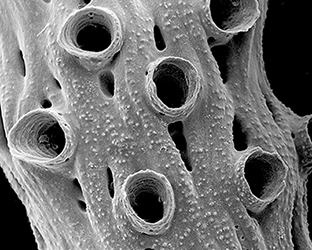
Every year on Taxonomist Appreciation Day, WoRMS (World Register Marine Species) organises a competition for the most remarkable marine species described during the year.
And for the first time, a species described in Zoosystema is included in the 2020 list of winners, namely the cryptic bryozoan Hornera mediterranea described by Jean-Georges Harmelin in his article
The Mediterranean species of Hornera Lamouroux, 1821 (Bryozoa, Cyclostomata): reassessment of H. frondiculata (Lamarck, 1816) and description of H. mediterranea n. sp.

Bryozoans are a largely overlooked group of colonial invertebrates that live in aquatic environments worldwide. The colonies of different species are found in a variety of forms, from encrusting types that grow on a substrate such as rock, shells or seaweeds, to those that build exoskeletons resembling corals. This new species is one of the beautiful branching bryozoans and is found in the Mediterranean Sea, perhaps one of the best studied seas in the world. This new species has been overlooked because of problems in the naming of the known species for more than a century.
The description of this new species of bryozoan, Hornera mediterranea, was achieved following lengthy investigations of a “cold case” involving unresolved questions incorporating both taxonomic and conservation issues.
It was necessary to first find out which species was hidden behind the name Hornera lichenoides (Linnaeus, 1758), which is a species known from Arctic and northerly waters, and was designated as the only bryozoan to be strictly protected in the Mediterranean Sea, which is where the confusion began. Perhaps this name actually referred to the well-known Hornera frondiculata (Lamarck, 1816), or perhaps to another species? Hornera frondiculata, thanks to its large size and the beauty of its branching design, was one of the first bryozoans to be pictured by ancient naturalists. It was also necessary to find out the identity of the unnamed, slender and delicately branching Hornera species which coexisted in the Mediterranean Sea along with H. frondiculata.
Characterization of cyclostome bryozoan species is not an easy task, but thanks to the comprehensive study of abundant material, from depths of 55–220 m, collected by diving and dredging around Marseille over the last 50 years, and the use of scanning electronic microscopy, we now have a clear understanding of this new species.
The name given to the species, Hornera mediterranea, is a tribute to A. W. Waters, an English naturalist who had recognized the existence of a second Hornera species in the Mediterranean. He had proposed the species name mediterranea in 1904, but because it was not described and there was no type specimen, this was not recognised… until now.
Discover the history of this new species with the video from the Parc national des Calanques "Le voile enfin levé sur une mystérieuse espèce de Méditerranée - Hornera mediterranea, Jo Harmelin" (in French)
More work by Jean-Georges Harmelin published in MNHN journals: https://sciencepress.mnhn.fr/en/auteurs/jean-georges-harmelin
Top 10 most remarkable new marine species from 2020: https://lifewatch.be/en/worms-top10-2020